K.R. Gastreich's Blog, page 38
September 9, 2012
The Tavern: Just a trope or something more?
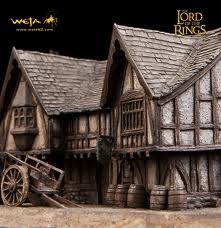

Hello world! As the banner on the site will tell you, the wonderful ladies of Heroines of Fantasy have decided to add a male voice to the blog. I am humbled by the generosity of my sister authors from Hadley Rille Books. I hope I can add one or two bits and pieces to this experience. Thanks in advance for all who visit this site. All of us here on HoFare dedicated to the idea of ‘story’, and the MOST important element in that equation is the READER. Thanks for coming!
When I considered what I might do for my first post, I was neck-deep in edits for novel number two, and I realized I had a number of important scenes taking place in taverns and inns. I don’t feel too uneasy about that because two of my main characters are poets forced to make their way as entertainers of sorts. I see a role for the ale-house-wine-shop-village watering hole in my stories, but I am still forced to confront the questionable use of what many consider an over-used scenario.
In other words, what is the deal with all the inns and taverns in fantasy?
I have read quite a few blog posts and critical articles decrying the “trope”: those elements that get so overused that they become hackneyed and stale to the point of being crutches for bad writers to cling to when they need help with a story. Others have exhaustingly catalogued these tropes (just word itself suggests tired and misdirected), so I won’t add any more invective to the pile. I get it. Certain images and situations seem to get overused in fantasy more than in other genres. Why that happens is Today I want to talk about taverns or inns and make an apology of sorts for their frequent use in fantasy novels. I come by my affliction by inclination because I’ve been addicted to Middle Earth and all its incarnations since I first heard about Bilbo’s mad dash down the hill to meet the dwarves at the Green Dragon in Bywater. In fact, Tolkien probably did more to cement the idea of the tavern/inn as a staple of fantasy than anyone else. We could blame him for all the copy-cat crutch use since, or we could take another look at the role taverns have played and temper our judgement.
The simple truth is we love our taverns. We frequent them. We take ownership of them (rugby gangs, anyone?). We leave bits and pieces of ourselves in them (my initials are still legible on a brick in the inner wall of the Tav in Ellensburg, Washington). We name our chat rooms after them! I know this because I was the one back in the early days of theonering.net who won the contest to name the chatroom. “Barliman’s” seemed appropriate. I wish I had figured out how to use the snazzy email they gave as the prize. I was too much a hobbit to figure out how to incorporate Vetch@theonering.net into my non-techie email universe. The tavern is part of our cultural identity, so it stands to reason that it should enter our fiction as well. And it is when we ill-use the tavern in our fiction that we create the trope argument so pervasive in the genre criticism. They can’t just be set pieces placed to allow a writer to move characters around and create chaos and conflict. They work best when they serve their deeper purpose in the world the writer creates.
In Tolkien’s world, the tavern stood for civility in a wild world, a gathering place for locals and travelers to interact and share news of the road. They helped knit Tolkien’s pre-industrial, not-everyone-has-a-palantir environment together. For the professor, the inn helped define part of the human experience in middle earth. Anyone ever come across a Dwarfish tavern? An Elvish waystation? Nope. Taverns show up in Middle Earth in places where Men and their near cousins the Hobbits settled. Man built the roads in Middle Earth. Everybody else built really interesting things, kingdoms and enclaves and refuges and such, but Man is the one who knit all the various places together by a system of roads, villages and towns. There are wonderful hints of how widespread the Numenorean culture was throughout The Lord of the Rings. In fact, some of the earliest writings Tolkien put together were the tales and poems that take pace in the ‘cottage of lost play’…nice euphemism for a tavern from my so-very-temporary-human perspective. Let’s face it, Tolkien liked his pipes and his pints. The Inklings were vital to his creative genius, so it should come as no surprise that taverns in all their convivial glory appear in his writing where it dealt with the world of Man/Hobbits.
For JRRT, the tavern was a sign of elevated culture. Where are the references to ale-houses in Rohan? Laketown? I can’t find any (although Tolkien does give hints to trade—wine barrels down the river, etc, that is suggestive). All the references seem to point to the Shire, Bree, Tharbad, and Minas Tirith. Settled places. Places where people collected for pints and news. Places where trade occurs.
Do we give the professor a pass on his use of the trope? I think we should because he avoids the kinds of mistakes that so many others make. I point to several instances where his use of the tavern serves an important moment in LOTR. Sam’s early interaction at the Green Dragon prefigures the reality of the Ents and also illustrates his romantic, sensitive nature that will bear such wonderful fruit later on in the story. The other, of course, is how he uses The Prancing Pony at Bree. In his letters and other writings, he tells us the story stalled at Bree. Maybe intuitively he knew he was at a contrived place. What leads me to give him the pass here is how well he developed Barliman and his inn as an integral plot element of the story. In fact, nearly everything that happens later in the tale hinges on the way things unfold at The Prancing Pony.
I’m not talking about Frodo and the ring or Aragorn in the shadows or Nazgul blades in the night.
I’m talking about an undelivered letter. Butterbur’s establishment was so much more than a place for events to happen. Tolkien lovingly establishes its local and regional importance. Barliman was the unofficial postmaster for the district, and if he had managed to get that note to Frodo in time, the Fellowship would have been a far different and less exciting story.
And this is where I feel the most strongly about how we use our ‘places’ in our stories. Great events transpire in Tolkien’s Bree: violence, terror, character, intrigue. These sorts of things appear over and over again in other novels incorporating the tavern, and we get the accusations of ‘tropeness’ when THAT’S ALL THAT HAPPENS.
Bree is actually where the hobbits' growth begins in earnest. It is the place at the end of the novel where we, and they, see the results of that growth. It knits together the tale like it knits together the culture within which Tolkien makes it exist. It is not just a plot device designed to introduce Strider. It is a reminder of what happens when communication goes awry.
Frankly, I like taverns. I like using them in my own writing because the world my characters inhabit need them for poetry duels, assignations and rest.
I am sure my defense of the tavern/inn has holes. I’d like to read what all of you think about taverns and various other ‘places’ that seem to pop up time and time again in fantasy.
Mark Nelson
Published on September 09, 2012 12:14
September 3, 2012
Happy Birthday, Heroines of Fantasy!
This month we are celebrating one year of being on line. It's been an exciting twelve months for us, with great posts, interesting debates and a wonderful contributions by many guest authors. Thank you so much to everyone who has participated by visiting our site, writing guest posts, and joining in the conversation through your comments and insights.
 A new year always brings changes. One of the changes we are most excited about is the addition of a fourth regular contributing author, Mark Nelson. Mark's debut novel, Poets of Pevana, was released this year by Hadley Rille Books. The book is an engaging journey into a complex world where poets -- and poetry -- lead the way in the resistance against a brutal and insidiously repressive regime. We are all very excited to welcome Mark to Heroines of Fantasy. Look for his first regular post, and a chance to win a free signed copy of his novel, later this month.
A new year always brings changes. One of the changes we are most excited about is the addition of a fourth regular contributing author, Mark Nelson. Mark's debut novel, Poets of Pevana, was released this year by Hadley Rille Books. The book is an engaging journey into a complex world where poets -- and poetry -- lead the way in the resistance against a brutal and insidiously repressive regime. We are all very excited to welcome Mark to Heroines of Fantasy. Look for his first regular post, and a chance to win a free signed copy of his novel, later this month.
Speaking of Hadley Rille Books, our beloved small press has decided to celebrate HoF's birthday with a $0.99 sale on all electronic editions (Kindle and Nook) of our novels. Check out the right-hand bar for purchase links to each title. This sale is for a limited time only, so take advantage of it now.
Those are my birthday announcements. Now on to my post...
For the coming 12-month cycle, we've set up a calendar of topics by month. Not everyone will be posting all the time on the monthly topic, but you will start seeing some continuity within months, and hopefully more variety between months, in terms of what we decide to write about.
September's theme comes courtesy of Terri-Lynne DeFino, who has asked that this month we all write about place in fantasy, and how certain areas of the world inspired the landscapes in which we have set our stories.
Moisehén -- the kingdom in which Eolyn lives -- is actually a strange amalgamation of places. Most people who read the novel would place it, correctly, in medieval Europe. The seeds of Moisehén were Germanic, planted by trips I made to visit family in Frankfurt, Bavaria, and I think most importantly, the regions of North Rhine-Westphalia and Hessen. I have both maternal and paternal roots in Germany, and so from a very young age was enamored of this land of medieval castles and rolling hills, fertile fields and dense forests. Castles like this one in Marburg, Germany, provided fertile
Castles like this one in Marburg, Germany, provided fertile
ground for my childhood imagination. By the time I got around to writing Eolyn however, I had been to a few more places. Most importantly, I'd spent about ten years living and working in Costa Rica, getting to know its people and its history.
The colonial era of Central America, in particular, held a special fascination for me. Costa Rica developed in a way that was very distinct from other provinces. The elite Spaniards that colonized the Central Valley were wealthy in land, but had very little capital. This set up a very different social dynamic compared to what happened in other colonial provinces such as Nicaragua and Guatemala.
When I began to shape the different provinces of Moisehén, I modeled the province of Moehn -- where Eolyn is from -- after the Central Valley of Costa Rica, as I imagined it during the colonial era. Both Moehn and the Central Valley are higher in elevation compared to the rest of the country. They are surrounded by mountains with access through a limited number of passes. They both have very fertile land fed by copious rainfall and volcanic ash.
Of course, there are many important differences between the Central Valley and Moehn. One of these is that the Central Valley eventually became the center of power in Costa Rica. Moehn is and will always be a marginal province with limited power in the grand scheme of things.
 One of the gateways to the oak-dominated
One of the gateways to the oak-dominated
forests of Talamanca in Costa Rica.The forest that inspired the South Woods, where Eolyn grows up, was not a European forest but a tropical one. The higher elevations of Talamanca, the mountain range that runs from Costa Rica to Panama, are cloaked in a magnificent forest dominated by oak trees and inhabited by many marvelous creatures, including -- according to local legend -- the magical and elusive duendes. In many ways, Talamanca took the seeds planted by my childhood trips to Germany and gave them life, allowing me to weave the many threads of inspiration into the single story that would become Eolyn.
I could go on about this for a while -- and have in other places and other posts -- but I think I will leave my reflections on the landscape of Moisehén at that for now.
I would like to finish by mentioning that while Moisehén has provided an important context for my stories, it is not the only landscape in which I write. It just happens to be the only landscape in which I have crafted a novel. But my short stories have taken me other places. Turning Point, for example, is set in the contemporary world of High Talamanca. When Sally Met Ben could be interpreted as a Midwest 1970s suburban setting. Creatures of Light, which I will begin weaving into a full-length novel in the not-so-distant future, is set in a Mediterranean-like world of the 17th/18th century.
This is one of the great things about writing and reading fantasy -- the possibilities of landscape are endless, especially if you give yourself the freedom to combine more than one period and location into a single world.
~ posted by Karin Rita Gastreich
 A new year always brings changes. One of the changes we are most excited about is the addition of a fourth regular contributing author, Mark Nelson. Mark's debut novel, Poets of Pevana, was released this year by Hadley Rille Books. The book is an engaging journey into a complex world where poets -- and poetry -- lead the way in the resistance against a brutal and insidiously repressive regime. We are all very excited to welcome Mark to Heroines of Fantasy. Look for his first regular post, and a chance to win a free signed copy of his novel, later this month.
A new year always brings changes. One of the changes we are most excited about is the addition of a fourth regular contributing author, Mark Nelson. Mark's debut novel, Poets of Pevana, was released this year by Hadley Rille Books. The book is an engaging journey into a complex world where poets -- and poetry -- lead the way in the resistance against a brutal and insidiously repressive regime. We are all very excited to welcome Mark to Heroines of Fantasy. Look for his first regular post, and a chance to win a free signed copy of his novel, later this month. Speaking of Hadley Rille Books, our beloved small press has decided to celebrate HoF's birthday with a $0.99 sale on all electronic editions (Kindle and Nook) of our novels. Check out the right-hand bar for purchase links to each title. This sale is for a limited time only, so take advantage of it now.
Those are my birthday announcements. Now on to my post...
For the coming 12-month cycle, we've set up a calendar of topics by month. Not everyone will be posting all the time on the monthly topic, but you will start seeing some continuity within months, and hopefully more variety between months, in terms of what we decide to write about.
September's theme comes courtesy of Terri-Lynne DeFino, who has asked that this month we all write about place in fantasy, and how certain areas of the world inspired the landscapes in which we have set our stories.
Moisehén -- the kingdom in which Eolyn lives -- is actually a strange amalgamation of places. Most people who read the novel would place it, correctly, in medieval Europe. The seeds of Moisehén were Germanic, planted by trips I made to visit family in Frankfurt, Bavaria, and I think most importantly, the regions of North Rhine-Westphalia and Hessen. I have both maternal and paternal roots in Germany, and so from a very young age was enamored of this land of medieval castles and rolling hills, fertile fields and dense forests.
 Castles like this one in Marburg, Germany, provided fertile
Castles like this one in Marburg, Germany, provided fertile ground for my childhood imagination. By the time I got around to writing Eolyn however, I had been to a few more places. Most importantly, I'd spent about ten years living and working in Costa Rica, getting to know its people and its history.
The colonial era of Central America, in particular, held a special fascination for me. Costa Rica developed in a way that was very distinct from other provinces. The elite Spaniards that colonized the Central Valley were wealthy in land, but had very little capital. This set up a very different social dynamic compared to what happened in other colonial provinces such as Nicaragua and Guatemala.
When I began to shape the different provinces of Moisehén, I modeled the province of Moehn -- where Eolyn is from -- after the Central Valley of Costa Rica, as I imagined it during the colonial era. Both Moehn and the Central Valley are higher in elevation compared to the rest of the country. They are surrounded by mountains with access through a limited number of passes. They both have very fertile land fed by copious rainfall and volcanic ash.
Of course, there are many important differences between the Central Valley and Moehn. One of these is that the Central Valley eventually became the center of power in Costa Rica. Moehn is and will always be a marginal province with limited power in the grand scheme of things.
 One of the gateways to the oak-dominated
One of the gateways to the oak-dominated forests of Talamanca in Costa Rica.The forest that inspired the South Woods, where Eolyn grows up, was not a European forest but a tropical one. The higher elevations of Talamanca, the mountain range that runs from Costa Rica to Panama, are cloaked in a magnificent forest dominated by oak trees and inhabited by many marvelous creatures, including -- according to local legend -- the magical and elusive duendes. In many ways, Talamanca took the seeds planted by my childhood trips to Germany and gave them life, allowing me to weave the many threads of inspiration into the single story that would become Eolyn.
I could go on about this for a while -- and have in other places and other posts -- but I think I will leave my reflections on the landscape of Moisehén at that for now.
I would like to finish by mentioning that while Moisehén has provided an important context for my stories, it is not the only landscape in which I write. It just happens to be the only landscape in which I have crafted a novel. But my short stories have taken me other places. Turning Point, for example, is set in the contemporary world of High Talamanca. When Sally Met Ben could be interpreted as a Midwest 1970s suburban setting. Creatures of Light, which I will begin weaving into a full-length novel in the not-so-distant future, is set in a Mediterranean-like world of the 17th/18th century.
This is one of the great things about writing and reading fantasy -- the possibilities of landscape are endless, especially if you give yourself the freedom to combine more than one period and location into a single world.
~ posted by Karin Rita Gastreich
Published on September 03, 2012 13:03
August 27, 2012
Summer is over and gone...
The crickets sang in the grasses. They sang the song of summer’s ending, a sad, monotonous song. “Summer is over and gone,” they sang. “Over and gone, over and gone. Summer is dying, dying.”
The crickets felt it was their duty to warn everybody that summertime cannot last forever. Even on the most beautiful days in the whole year — the days when summer is changing into fall the crickets spread the rumor of sadness and change.
~Charlotte's Web (The Crickets)
 That bit out of
Charlotte's Web
has always stuck with me. It's my first thought when I hear August's crickets chirping to the night. I'm listening to them now, that twinkling sound; that glorious chorus punctuated by the bzzt-bzzt-bzzt and click-click-tick of katydids joining in. It brings me such joy, contentment; and melancholy.
That bit out of
Charlotte's Web
has always stuck with me. It's my first thought when I hear August's crickets chirping to the night. I'm listening to them now, that twinkling sound; that glorious chorus punctuated by the bzzt-bzzt-bzzt and click-click-tick of katydids joining in. It brings me such joy, contentment; and melancholy.Summer is over and gone, over and gone...
Long ago summers of green ghost and States and staying out until the ungodly hour of nine o'clock. We were such hooligans, running the suburban streets until such an hour. What were our parents thinking? Magical summer. Anything was possible.We were young and wild and freer than we'd ever be again. We were good and stupid and kind and mean. We were kids for whom summer ended exactly on Labor Day, heralded by cricketsong.
Summer is over and gone, over and gone...
I remember, straddling my Baracuda 3-speed bicycle, curls sweat-plastered to my face, ready to race my brother's best friend (who I had a not-so-secret crush on.) Playing cards clothes-pinned to my spokes, basket on the handlebars--and fringe. I was ready. My brother had a cap gun, to make it official and all; bang! I pedaled with everything I had, but my not-so-secret crush was bigger and his bike was a ten-speed. He won. Chivalry among children does not exist.

Summer is over and gone, over and gone...
I remember picking mulberries. I liked them slightly less than ripe: deep red at the bottom, kind of pink at the top. That sour tang, that burst of sweet. We ate them straight off the tree. No pesticides, no fertilizer to worry about. Pop-pop-pop, in they went. What we couldn't eat, we baked into pies or smooshed on one another. Strategically. Not quite in naughty spots, but close enough to giggle over.
Summer is over and gone, over and gone...
I remember walking to the Milk Jug to buy ice cream with my brothers and sister, running through the sprinkler, rolling down the hill. We built a fort out of the crates (real wooden ones) our new washer and dryer and refrigerator came in. Being inside was like crawling into an oven. (What were our parents thinking??) Labor Day approached, and the church bazaar my parents helped to run. The last big bang before school and homework and getting to bed on time. My dad always ran the basketball hoop game. "Hit the road, kid, you're bothering me!" was his favorite line, said with a smile and a quarter slipped into my sticky palm--no matter how many times I came back begging. I always played HON on the wheel. It only cost about a million dollars in quarters to win the bedspread doll I'd coveted all week long.
Summer is over and gone, over and gone...
But not really. Never really. It lives through autumn and winter and spring. It did then. It does now. It lives through the years, waiting. For cricketsong to bring it to life. For the smile. For the breath of life blown into it, just for a moment.
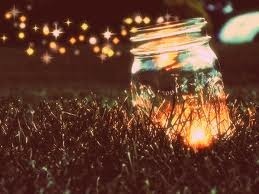
What summer memories do you have to share? Any one (or three!) will do.
Published on August 27, 2012 06:00
August 20, 2012
What I Did This Summer
 A scene from my summer adventures
A scene from my summer adventuresin the high Talamanca of Costa Rica.If I had any lingering doubts about summer drawing to a close, they were obliterated this past week in back-to-back faculty and staff meetings at Avila. Classes start on Wednesday, and though my week of meetings has left me in a rather unpleasant mood, I'm looking forward to seeing my students and getting started with fall semester.
I was trying to think of what to write on HoF this week, when I remembered that way back when I was in grade school, our first homework assignment often consisted of an essay about what we did over the summer. Wow, those were painful to write. Even on the few occasions that I actually had something interesting to say. Now, having graded a fair number of student essays over the years, I wonder just how painful they were for my teachers to read.
In any case, that little memory sparked the idea for this week's post. Don't worry! I won't subject you to an essay about what I did over the summer. Though I do have interesting stories to tell, and if you want to read more about my adventures as a field ecologist in the rain forests of Central America, I invite you to visit my blog for Eolyn.
What I will do on HoF is share with you a product of the summer: an audio recording of an excerpt from the near-final (I hope!) draft of High Maga, the companion novel to Eolyn.
Those of you who read Eolyn will recognize only two characters in this scene: Eolyn, and the South Woods. There is a third character, Sir Borten, a loyal knight of King Akmael, who appeared in Eolyn, but his role was minor enough that few probably remember him. Everyone else is new: Delric, also a knight of the King, and two of Eolyn's young students in magic, Melanie and Sirena.
A disclaimer before you listen to the recording, and an apology. The disclaimer is that the manuscript has yet to undergo an editor's redpen, so what you hear may be significantly altered -- or even deleted -- before the novel goes to press.
My apology? Well, I've been getting over a very bad cold, so that might affect the quality of my reading.
'Nuf said. Here's the recording, and when you're done listening (or even if you decide not to listen), I'd love to hear about what you did over the summer, too.
Posted by Karin Rita Gastreich
Published on August 20, 2012 06:00
August 13, 2012
Writing Female Characters
 Please welcome our August guest, Jim C. Hines, author of the Goblin Quest books and the Princess series, "often described as a blend of Grimm's Fairy Tales with Charlie's Angels" (jimchines.com). He is an outspoken advocate of women's issues on his blog, where he addresses a variety of topics from rape awareness to depictions of women in cover art. His most recent novel, Libriomancer, debuted August 7th.
Please welcome our August guest, Jim C. Hines, author of the Goblin Quest books and the Princess series, "often described as a blend of Grimm's Fairy Tales with Charlie's Angels" (jimchines.com). He is an outspoken advocate of women's issues on his blog, where he addresses a variety of topics from rape awareness to depictions of women in cover art. His most recent novel, Libriomancer, debuted August 7th. First of all, my thanks to Kim for the invitation to do a little guest babbling! Kim suggested I could talk about “the perspective of a man who writes women characters well.” (Thank you!) So I figured I’d share the secret.
Ultimately, I think this is the key to learning how to write female characters, and I’m going to share it with you all.
Here it is. The big important secret that, unfortunately, some of us still struggle with. Are you ready?
Women are people.
Shocking, right? But I think some writers tend to forget this point, or even worse, never learned it. Sometimes women are nothing but trophies to be won, the hero’s prize after a valiant quest. (This is one of several reasons I can’t stand most of the original Sleeping Beauty stories.) Alternately, women can be used to motivate the hero. “Women in Refrigerators” is a good example of this syndrome. (Google it if you’re not familiar with the phrase.)
 I do think we’ve gotten better over the years. Heck, these days you can find all sorts of Strong Women Characters™ in urban fantasy and elsewhere. Yet, as I read these stories, I can’t help noticing how often the Strong Woman Character™ falls into a particular, somewhat narrow definition: tough, cynical, sexy, and physically kick-ass. And don’t get me started on the cover art and poses.
I do think we’ve gotten better over the years. Heck, these days you can find all sorts of Strong Women Characters™ in urban fantasy and elsewhere. Yet, as I read these stories, I can’t help noticing how often the Strong Woman Character™ falls into a particular, somewhat narrow definition: tough, cynical, sexy, and physically kick-ass. And don’t get me started on the cover art and poses.Now, I happen to like kick-ass heroines. I was a big fan of Buffy and Faith. I enjoy watching Black Widow hold her own against the bad guys, or reading about women taking on vampires, werewolves, demons, and whatever other monsters have come along to threaten them.
But that can’t be all there is. If the only significant female character is the Strong Woman Character™, then that’s a problem. If she’s the only character getting any time in the stories, then we’re not really reading about women. We’re reading about one particular subtype of woman, while erasing all the rest.
 I remember the first time someone said they thought the strongest female character in my book Goblin Hero wasn’t the goblin wizard-in-training, nor was she the goblin chef with a spoon that could crack skulls; the strongest character was Grell, an elderly goblin who hobbled about on two wooden canes. In terms of combat, she was pretty much the least capable of defending herself (with the possible exception of Braf, who was just as likely to incapacitate himself in a nose-picking accident).
I remember the first time someone said they thought the strongest female character in my book Goblin Hero wasn’t the goblin wizard-in-training, nor was she the goblin chef with a spoon that could crack skulls; the strongest character was Grell, an elderly goblin who hobbled about on two wooden canes. In terms of combat, she was pretty much the least capable of defending herself (with the possible exception of Braf, who was just as likely to incapacitate himself in a nose-picking accident).But she was smart, she was cranky, and she was perfectly capable of manipulating the other goblins into getting killed instead of her. She was a fun character to write, in part because I wasn’t trying to fit her into a narrowly-defined subcategory.
Janet Kagan wrote great female characters, because they were characters first and foremost. They were people, fully-developed with their own quirks and strengths and fears. They were real. The fact that they were female was a part of who they were as characters, but it didn’t define them. They were individuals with their own stories.
I’ve talked to a number of new writers who struggle with how to write female characters. Or non-white characters. Or LGBT characters. I struggled myself when I was starting out. The problem is when we try to define the characters by that one dimension. That approach, shocking as this may sound, leads to one-dimensional, stereotypical characters. Women are people. You’d be amazed how much better a story gets when the author treats them that way.
Published on August 13, 2012 00:00
August 7, 2012
Modern Heroes
Like much of the world, I’ve been caught up in the excitement of the summer Olympics. When I was a child, I wanted to be Mary Lou Retton, springing off the vault to victorious gold. I also toyed with the idea of becoming an Olympic swimmer or diver, perhaps even a synchronized swimmer. Naturally, during the winter Olympics, figure skating was my dream event. Let’s forget for a moment that I hated P.E. and most of my recreational activities were…uh…reading.
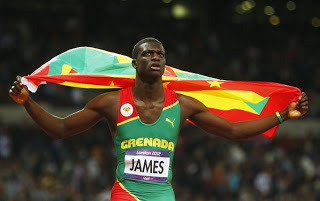 Kirani James brings home Grenada's first ever gold medal.Now that I have composted those dreams to nourish others, I find that I watch the competitions for different reasons. Rather than look at them as “how tos” or as tools of inspiration, I am most interested in the stories behind the athletes. Where did they come from? How did they get to the Olympics? What sacrifices were made? Are they realizing their dreams, or going home crushed? Why do they succeed at those events? What qualities and characters make them who they are, and what do we see in them that drives us to watch, to cheer them one, to feel genuine empathy when they lose?
Kirani James brings home Grenada's first ever gold medal.Now that I have composted those dreams to nourish others, I find that I watch the competitions for different reasons. Rather than look at them as “how tos” or as tools of inspiration, I am most interested in the stories behind the athletes. Where did they come from? How did they get to the Olympics? What sacrifices were made? Are they realizing their dreams, or going home crushed? Why do they succeed at those events? What qualities and characters make them who they are, and what do we see in them that drives us to watch, to cheer them one, to feel genuine empathy when they lose? The answers to those questions provide endless opportunities for writers. Commentators and critics, both professional and armchair, can pick away at body types or hair, but ultimately, those athletes are playing and performing their hearts out at the end of a long road that included hard, physical work, mental toughness, trying, failing, trying again, failing again, injury, dedication, determination, personal and financial obstacles, conditioning… and the list goes on.
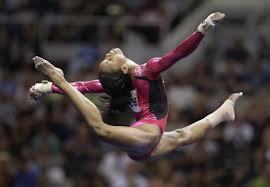 Gabby Douglas left her home and family to train in Iowa.If we look closely enough, we discover that their stories follow the classic hero’s journey. A talent discovered. An athlete mentored, trained as far as he or she can go, only to be forced to leave that mentor, and sometimes home and family, to take his or her skills to the next level. The athlete, like the hero, faces obstacles to be overcome; is tested, sometimes multiple times, and must face the consequences of failure before he or she can claim victory.
Gabby Douglas left her home and family to train in Iowa.If we look closely enough, we discover that their stories follow the classic hero’s journey. A talent discovered. An athlete mentored, trained as far as he or she can go, only to be forced to leave that mentor, and sometimes home and family, to take his or her skills to the next level. The athlete, like the hero, faces obstacles to be overcome; is tested, sometimes multiple times, and must face the consequences of failure before he or she can claim victory. These are our modern heroes. Our warriors. They wear our colors and fight for our honor. In a world that is rather bleak at times, where so many are losing homes and jobs, scrounging pennies to put food on the table, the Olympic warriors still give us hope. Just like our sword or magic-wielding heroes in fantasy, they stand for what is good and right, and we can’t help but admire them. They shine a little light of peace into our tumultuous world, and show us that for many, the impossible can become possible.
 South Africa's Oscar Pistorius.As I prepare to outline the third book of my series at the end of this summer, I’m going to have many of these athletes and their stories on my mind, particularly the qualities and characteristics that drive them to accomplish amazing feats. Are they perfect? No. I’m sure some of them are assholes or kick puppies in their spare time. But for now, I’m going to admire their almost superhuman strength, endurance, and determination to overcome and pretend that the world is a little better this month for having the Olympics in it once again. And then I'm going to use their examples to flesh out my characters so that my heroes ring true to readers.
South Africa's Oscar Pistorius.As I prepare to outline the third book of my series at the end of this summer, I’m going to have many of these athletes and their stories on my mind, particularly the qualities and characteristics that drive them to accomplish amazing feats. Are they perfect? No. I’m sure some of them are assholes or kick puppies in their spare time. But for now, I’m going to admire their almost superhuman strength, endurance, and determination to overcome and pretend that the world is a little better this month for having the Olympics in it once again. And then I'm going to use their examples to flesh out my characters so that my heroes ring true to readers.~Kim Vandervort
Published on August 07, 2012 22:20
July 30, 2012
Writing the Other with Fear and Trembling, Try and Caring
 Please welcome our second July guest, Ken Scholes! A prolific author of both short fiction and novels, Ken is currently hard at work writing Requiem, the fourth book in his fantastic Psalms of Isaak series. For a full biography, visit kenscholes.com or check him out on facebook.
Please welcome our second July guest, Ken Scholes! A prolific author of both short fiction and novels, Ken is currently hard at work writing Requiem, the fourth book in his fantastic Psalms of Isaak series. For a full biography, visit kenscholes.com or check him out on facebook.
I was very flattered when Kim asked me to write a guest post here but if I’m completely honest, I was more than a little nervous…and I still am. Because in talking about possible topics, one that she suggested – the one I’ve ultimately chosen to tackle – centered around how I write such great, strong female characters.
The truth is, I’m not convinced that I do. I’ve had some feedback that says I am getting a lot of it right but I’ve also had feedback that suggests I’m getting it wrong. And I suspect that as with many things in life-- maybe even most things-- it’s not an “either/or” equation, but a “both/and.” I’m getting it both wrong and right at the same time.
Add to that truth that this is a topic that quickly reduces down to online “fail” wars that I’ve seen brutalize well-intentioned friends who are trying to navigate this important aspect of writing. As writers we’re frequently told to “write what we know” and this is largely sound advice…except that we really can’t just stay in that end of the pool if we want to write engaging fiction. I surely tried to.
So today’s post is going to be light on advice when it comes to the nuts and bolts…and heavier on issues of intent and awareness in my own personal journey into the territory of this topic.
But first, a bit about me because I think our own context is important when it comes to writing characters – and their own contexts -- that are different from us. I am a forty-four year old American male. My heritage is Scotch, Irish, English and Dutch. I am tall and plus-sized. I largely grew up in a rural environment – a small logging town at the foot of Mount Rainier. I think there were maybe four people of color, total, in my entire middle and high school experience. I was unaware of anyone in my school who was gay, lesbian, bisexual, transgender or queer. The only religious practices largely observed in my community were varieties of Christianity with a lot of Mormon, Catholic and Evangelical representation (a lot by Pacific Northwest standards). I was only aware of one agnostic in my youth. I grew up poor in a family riddled with abuse and neglect between a Borderline mother and an alcoholic stepfather. There is so much more that I could include here, but the point I’m trying to make is that with a context like that the cards were largely stacked against me becoming who I am today. And within that context, there was inherent privilege by nature of where I was born and the people who I was born to, biases instilled into me, lenses colored by upbringing, culture and experience that I wouldn’t even begin to plumb the depths of until later in my life.
It took a long time for me to recognize just how much things like privilege and bias impacted me. And even longer when it came to understanding that as a writer, I had the opportunity not just to entertain but also to gently influence my culture in the direction of evolving. Until I reached that place, I played it as safe as I could. In all of the short stories I wrote between 1997 and 2006, I attempted to write one African American protagonist and three female protagonists. I say attempted because I honestly think that for me, given my background, I can’t afford to believe I’m getting it right. Instead, I wrote mostly white male characters working through their redemption from apocalypse, fundamentalism, catastrophe and small-mindedness. I wrote what I knew.

And then the dare showed up. Jay Lake and my wife Jen dared me to write my first novel – an expansion of two short stories I’d set in what I was calling my Androfrancine Cycle. And so I set out to do so. And halfway into the book, my wife gently pointed out to me that the only female character with any kind of intent or agency was Jin Li Tam. I had slipped into writing what I knew again – reproducing the same issues that existed in much of the fiction I cut my teeth on as a kid. So with her loving encouragement – not her criticism -- I added a few more female characters to the book. Thirteen months after the dare, Lamentationwas picked up by Tor – along with the four unwritten volumes in the Psalms of Isaak, and by then, I was halfway into drafting Canticle and adding more diversity here and there with a great deal of fear and trembling. Then, in Antiphon, I realized instinctively that one of my favorite supporting characters from Canticlewas gay and in a relationship with another supporting character. It spontaneously flowed out of me in a scene where, after being separated for a long while and in great danger, they rush into each other’s arms to kiss. Those characters will continue to grow as I finish the series (just like the author will continue to grow). And I intend to flesh that out further in other stories coming down the road with these two, including telling the story of how they met and fell in love in the Churning Waste. Who knows what I’ll tackle in my next projects….
I know this is a lot of context. But I think when it comes to writing the other, we have to understand our own context…and be honest about it and the limitations it can present. My context reminds me to pay attention. I was raised with some pretty backward and terrible beliefs about a lot of others in our world. I can’t afford to not keep that in mind as I try to write the other. It is also good, at least for me, to keep in mind that this is a journey as I learn to turn over the rocks within myself to put light on the creepy, crawly things I find hidden there. Ideally, it’s an upward spiral as my mind opens up to see as far beyond my prejudices and privileges as they can see.
For me, it is also important to use as much empathy as possible in considering the other that I write. To really try considering life in their shoes. It’s hard to achieve anything close to empathy without actually investing myself into the other I want to write. So I think a lot and I ask a lot of questions. I actively work at meeting and befriending a wide, diverse group of friends and acquaintances. Writing the other is a lot more likely to come off poorly if the writer doesn’t actually know any others.
When it comes to feedback, I try not to assume and I try to stay open-minded when someone points out to me the places where I am or am not getting it right. I look (and listen) for good examples and I pay attention to the bad examples, too.
At the end of the day, I hope it is the fear and trembling, try and caring that will redeem my effort. Because I think all of these ingredients are what will keep me honest. I hope they will. A certain amount of fear and trembling – feeling the weight of why it is so important to aim higher. And a lot of caring enough to try – really try – to get it as close to real as possible so that my readers are invited to meet others familiar and unfamiliar to their own journeys.
I’ve said for a long time that fiction provides us a sandbox in which we can play with ideas that folks might not be comfortable exploring any other way. And though the first and foremost goal Is to tell stories that sweep our readers up and carry them away, we are also influencing our culture, easing it in a forward direction and putting light on our backwardness as a species in the way that we portray the people in our fiction and in the way that we portray their struggles.
We have to try. We have to care. And at least in my case, I have to write my others with a bit fear and trembling with my fingers crossed that I’ll get it more right than wrong as I do so.
Published on July 30, 2012 22:43
July 23, 2012
Writing a Four-Legged Heroine
 Photo by ThePetPhotographer.comIt is our pleasure this week to welcome Dorothy Hearst, author of Promise of the Wolves and Secrets of the Wolves.
Photo by ThePetPhotographer.comIt is our pleasure this week to welcome Dorothy Hearst, author of Promise of the Wolves and Secrets of the Wolves. I met Dorothy for the first time last fall, at the World Fantasy Convention in San Diego, where I had the good fortune of receiving a copy of Secrets of the Wolves in my bag of free books. This is a wonderful and engaging tale where the protagonist is not only a female, she is a wolf. The story is set in the period of prehistory where the ancestors of present-day dogs began their journey toward domestication, and is told entirely from the wolf's point of view, with extraordinarily accurate attention given to wolf behavior and social structure.
Before the wolves barged in the door, demanding that their story be told, Dorothy was a senior editor at Jossey-Bass, where she published books for nonprofit, public and social change leaders. The third book in her wolf trilogy is currently under construction. (And I can't wait to read it!)
***
 I always knew that when I started writing, I would write strong female protagonists. Like many girls growing up in the seventies and early eighties, I hungered for female characters who were not sidekicks, damsels in distress or love interests, and I cherished the amazing female protagonists available to me. I swore that if I ever wrote novels, I would write wonderful women and girls.
I always knew that when I started writing, I would write strong female protagonists. Like many girls growing up in the seventies and early eighties, I hungered for female characters who were not sidekicks, damsels in distress or love interests, and I cherished the amazing female protagonists available to me. I swore that if I ever wrote novels, I would write wonderful women and girls. When it turned out that my first novels insisted on being about wolves, that didn’t change. Promise of the Wolves and Secrets of the Wolves are about the domestication of the wolf from the wolf’s point of view. Since so much of the repression of women and girls seems to me to be about the taming of that which is feared, I was excited to explore the concept of taming from the perspective of a female wolf—a symbol of the wilderness we both hunger for and fear.
Kaala is a young shewolf living 14,000 years ago in the Wide Valley, where wolves are forbidden to have any contact with humans. When she saves the life of a human child she becomes an inadvertent rebel and begins her journey to become a leader of wolfkind. Kaala’s voice was sure and unapologetically strong right from the beginning. She had no intention of being anyone’s sidekick, and so right from the start I had my strong female protagonist. Her male companions—one wolf and one raven—made her more powerful to me rather than less.
I did not, however, want a superhero, a character with unusual strength or special skills that would make her less vulnerable than others. I wanted a different kind female power, that of a leader in the making. Kaala is an ordinary wolf thrust into extraordinary situations.
I also wanted Kaala to have to work for her power not because she was female, but because earning power and influence is part of the leader’s journey. This is where writing form a wolf’s point of view was a huge advantage; I wasn’t limited by human assumptions of femaleness and power.
Kaala’s wolfliness allowed me to write a heroine who didn’t have to challenge feminine norms in her world because wolves do not have human ideas of male and female power. I could write a heroine who didn’t have to overcome her femaleness in order to have authority, because she and those around her assumed that she has just as much right to power as any other wolf. I didn’t realize this when I first started writing the trilogy because for years people thought that all wolf packs were led by alpha males. Now it’s known that this is not always true. There are female pack leaders and, in fact, pack leadership is fluid with different wolves taking leadership at different tasks. The single alpha male wolf is a human construct based on the assumption that leadership must look male. Kaala does not have to overcome being female.
Kaala’s human counterpart, TaLi, has no such advantage. She’s the child Kaala rescues from a rushing river, and she is meant to be the next shaman of her village, which for years has accepted a balance between male and female power. By the time Kaala meets TaLi, however, this is changing. Both female power and the power of the natural world are being seen as threats. As the humans try to tame the natural world—including wolves and the shamans who run with them—they also are trying to tame their females. The contrast between the world of wolf power and the world of human power was one of the things that intrigued me. It’s a centerpiece of the third book of the trilogy, which I’m revising now.
Kaala is my first heroine. She won’t be my last and I’m looking forward to using what I’ve learned from her as I move forward in my writing and my life, and
Synopsis: Secrets of the Wolves
The rules of the Wide Valley wolves were clear: Never consort with humans; never kill a human unprovoked; never allow a mixed-blood wolf to live.
When she was little more than a pup, Kaala, born of mixed blood and allowed to live against the will of many in her pack, found herself irresistably drawn to the the forbidden humans. She shattered the rules of the valley and exposed the lies hidden beneath. Now the responsibility for the consqeuences rests with her. In the second installment of The Wolf Chronicles, Kaala -- with the help of her young packmates, the humans they have befriended, and an extremely opinionated raven -- must find a way for the wolves and humans of the Wide Valley to live in harmony. If they succeed, Kaala will finally prove herself worthy of her pack. If they fail, every wolf and human in the valley will die.
Then Kaala learns that the implications of her actions extend far beyond the Wide Valley. Humans, and their relationship to the wildness of the world around them, are changing, and the choices Kaala makes may affect not only her pack, but the survival of all wolf-kind.
Published on July 23, 2012 07:03
July 16, 2012
Sisterhood
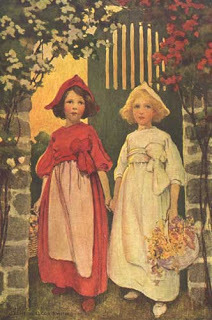 Snow White and Rose RedOne of my favorite Grimm’s Fairy Tales growing up was ‘Snow White and Rose Red’. This tale is not to be confused with the much more popular ‘Snow White and the Seven Dwarves’. The Snow White of ‘Snow White and Rose Red’ is a different character, with a distinct background, personality and story.
Snow White and Rose RedOne of my favorite Grimm’s Fairy Tales growing up was ‘Snow White and Rose Red’. This tale is not to be confused with the much more popular ‘Snow White and the Seven Dwarves’. The Snow White of ‘Snow White and Rose Red’ is a different character, with a distinct background, personality and story. Snow White and Rose Red are sisters who live with their widowed mother deep in the woods. Together they befriend a bear in winter time and rescue an ungrateful dwarf from a variety of unpleasant fates. Little do they know the bear is actually a prince under a curse cast by the dwarf. Each time they rescue the dwarf, they inadvertently take away some of his magic. This eventually results in the bear being able free himself from the curse by killing the dwarf. The prince takes Rose Red as his bride, and as luck would have it, successfully matches up his brother with Snow White. Both sisters not only live happily ever after, they live happily ever after together.
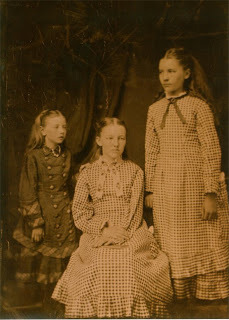 The Ingalls sisters: Caroline, Mary and LauraSisterhood is a repeated theme in many tales, and it has always appealed to me. Growing up, I was an avid follower of the Ingall's sisters in Laura Ingalls-Wilder’s classic Little House series.
The Ingalls sisters: Caroline, Mary and LauraSisterhood is a repeated theme in many tales, and it has always appealed to me. Growing up, I was an avid follower of the Ingall's sisters in Laura Ingalls-Wilder’s classic Little House series. When as an adult, I read The Other Boleyn Girl by Philippa Gregory, what impressed me most was not so much the retelling of Anne Boleyn’s story (after all, by then I knew how it all began and how it all would end), but the exceptional skill with which Gregory captured the essence of sisterhood: the love, the admiration, the jealousy and rivalry, the bond of blood and affection capable of withstanding almost anything, even the fatal political and sexual intrigues of the court of King Henry VIII.
 I wasn't very happy with the film interpretation of Gregory's
I wasn't very happy with the film interpretation of Gregory's novel, but Natalie Portman and Scarlett Johansen made
for a nice-looking pair of sisters.
More recently in the Hunger Games, the power of sisterhood has resurged with Katniss Everdeen taking the place of her sister Primrose, and becoming a hero – oops! I mean, a heroine -- before even stepping foot inside the Games.
I have been blessed with having a sister; so every time I read a story about sisters, I’m reminded of that relationship, and all that my sister has meant to me and given me over the years. Love, encouragement, faith in my ability to achieve my dreams, an example to aspire to, someone to care about, support and depend upon. Big sisters are especially wonderful because they so often serve the role of pathfinders. They are the ones who forge ahead into life’s unknown territories, and come back to share their wisdom with younger siblings.
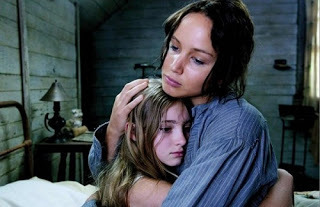 Katniss and Primrose from The Hunger Games have recently
Katniss and Primrose from The Hunger Games have recently been added to the list of famous sisters
In Eolyn’s world, sisterhood also has a special meaning. Eolyn herself has no biological sisters, but in the tradition of the Magas, all followers of the very first maga, Aithne, are sisters in magic. For the Magas, sisterhood transcends boundaries of time, place and bloodlines. One can even speak of ‘sisters’ who lived centuries ago. The Magas believe that all practitioners who have passed into the Afterlife continue to watch over their sisters in the world of the living. So while Eolyn is on her own for much of her journey, she is never truly alone with her magic.
These are some of my thoughts on sisterhood; it’s importance in our stories as well as in our lives. Now it’s your turn. What does “sisterhood” mean to you? Who are your favorite sisters in fiction and history, and why? How have your sisters, in blood and in spirit, made your life easier, more interesting, more fulfilling?
Posted by Karin Rita Gastreich
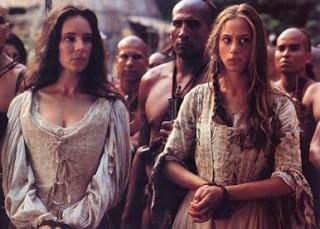 The Munro sisters, Cora and Alice, from the film
The Munro sisters, Cora and Alice, from the film The Last of the Mohicans. Like many sisters that live on in our
imaginations, their fates will not be happy ones.
Published on July 16, 2012 06:00
July 9, 2012
The Role of the Hausfrau
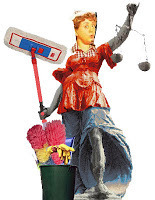 What a maligned role it has been--the hausfrau, the housewife, the keeper of the home always ready with a gentle hand, a warm bowl of something hearty, wisdom. She's quick with a broom and to stitch up a wound. She's most often a supporting character, by her very nature, because it's what she does--she supports. She succors. She cooks and cleans and wipes noses. She is the Eternal Mother, and everyone hates her.
What a maligned role it has been--the hausfrau, the housewife, the keeper of the home always ready with a gentle hand, a warm bowl of something hearty, wisdom. She's quick with a broom and to stitch up a wound. She's most often a supporting character, by her very nature, because it's what she does--she supports. She succors. She cooks and cleans and wipes noses. She is the Eternal Mother, and everyone hates her.No, I'm not a fan of Freud.
Hate is a strong word; let's call it dramatic emphasis. She's been picked apart so often for being what she is, called a trope and worse. I've read criticisms of David Edding's Polgara, for actually seeming to like her role as caretaker of everyone she comes across, because she, being one of the most powerful people in that particular world, should be more. And though I do understand that this became a trope because it was most often the only role given any woman in a fantasy novel, (and in life!) I can't help feeling she's being overlooked, or worse, looked down upon, as somehow not interesting enough, strong enough, valuable enough for our fiction abundant with warrior women.
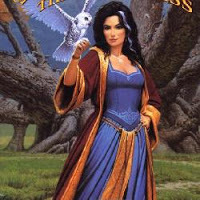
This is one of those subjects I, as a woman, a mother, and yes, a housewife, have struggled with through my life. I wiped the noses and cooked the food and kept the house while my husband brought home the paycheck that supported the household. Because he is him, I get to be me, and vice versa. It's traditional, for want of a better word, but it has worked for twenty four years.The key here is that it was a choice, not a societal mandate; and therein lies the difference.
I have spent way too much time defending the role I chose. There's no money, no prestige, very little outside validation of any kind. I've always been offended by the term working mother. I hated being asked, once my kids were all in school full time, if I was going back to work. The implication is there, no matter how innocently said; and this, I think, is part of what led to the hausfrau being one of those characters we just don't write.
But she's making a comeback, in a positive way. Can you guess who I'm going to cite?

Molly Weasley (Harry Potter Series.) She is a magically powerful woman. She can conjure up dinner, but she cooks it herself, for her family, with love. Her house is often a bit cluttered, but it's always clean. She tends her children, her husband and her home with the same ferocity with which she ultimately battles Death Eaters. Molly Weasley is the embodiment of mother, hausfrau, tender of the hearth and home--and she rocks.
 Hausfrau is never going to get a starring role. Her very nature makes her a supporting character, not a starring one; but she doesn't have to be a trope either. We need more of her. We need to love her again, because Wendy Darling isn't acquiescing to societies expectations unless we impose that on her; and neither is Molly Weasley. It's just who they are. Without them, Peter and the lost boys, Harry, Ron, Hermione and all the rest would not have lasted long enough to see the end of their stories.
Hausfrau is never going to get a starring role. Her very nature makes her a supporting character, not a starring one; but she doesn't have to be a trope either. We need more of her. We need to love her again, because Wendy Darling isn't acquiescing to societies expectations unless we impose that on her; and neither is Molly Weasley. It's just who they are. Without them, Peter and the lost boys, Harry, Ron, Hermione and all the rest would not have lasted long enough to see the end of their stories.Got a hausfrau for me? Let the list begin!
Published on July 09, 2012 05:00



